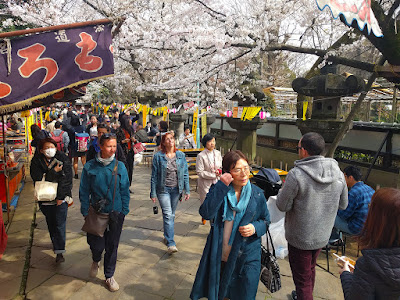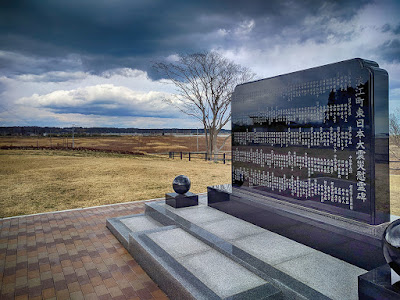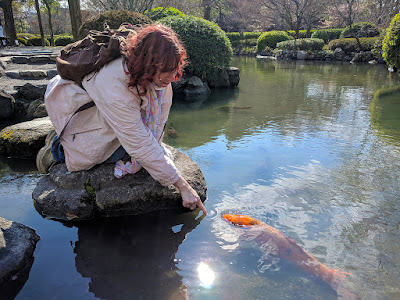Our last full day in Tokyo was probably the best time we spent in Japan. Jenny started the morning with a pilgrimage to the LDS temple, which she learned has been closed for renovation. But she still found time to enjoy the morning spirit at a quiet garden. When she returned, we charted a path to Ueno Park for some hanami (cherry blossom appreciation). While the sakura were blooming early this year, they had not yet reached their zenith. Even so, we loved the chance to walk around a lake filled with paddle boats and join the crowds drawn to trees bursting with white and pink petals that shimmied in the breeze.
Throughout the park, folks had laid
out blue tarps to gather with friends for food and (plentiful) drink. After
grabbing some regrettable street food, we found seats for a park performance
with a monkey doing leaps and other tricks. [Yes, it was an impressive display.
But I still felt guilty all the same.] A surprising highlight was the discovery
of one of those ubiquitous gachapon dispensers that sold, of all things,
miniature gachapon dispensers. And only for 200 Yen each. I would have
cheerfully paid twice as much, so I bought six of the danged things! Later on, we wandered the stalls and shops of Ameyoko Shopping Street, snarfing up souvenirs and finding the perfect brand of matcha tea to bring home.
That evening we had dinner at Ninja
Akasaka, a place that is pricey, cheesy, and surprisingly good. So, what’s the
concept? Turns out, your server is a ninja who guides you through a mysterious
network of passageways, past darkened rooms, across broken bridges, and through
secret portals. Then when your meal arrives, your ninja performs illusions and
tells goofy jokes. I’d long looked forward to this evening, and was
disappointed the night before when we went through the whole opening bit - only
to be dropped off in the bar. Yeah, you really do need reservations for this
place. So we paid for our drinks and opted out of the festivities, arranging a
reservation for today (and triple-checking that we’d snagged one of those
coveted private rooms). It was worth the wait.
To be sure, neither Jenny nor I would
ever be confused for “foodies.” So I have little experience for comparison. But
I’d say that this was the best meal we’ve ever had: shuriken star-blades
grissini, white fish and tomato ceviche, turban shell bomb with garlic butter,
stone-boiled soup, Wagyu beef, sushi with akadashi dark-miso soup, and plenty
of palate cleansers and tasty desserts.
Afterward we seriously considered
calling it a night, but Jenny was still up for adventure. So we returned to the
subway for a visit to Starbucks Reserve Roastery. I know, I know… But, really,
this is a remarkable place - and at four stories and 32,000-square-feet is the
largest Starbucks on the planet. We showed up at around 9:30 p.m. and found a
line stretching down the road. And the display on one fellow’s clipboard read
120 minutes. Nope! So we walked about along the river, savoring the sight of cherry
blossoms illuminated by lights.
Then I figured, let’s see just how
bad the line really is. As it turns out, we only needed to wait about 20 minutes.
Inside, we immersed ourselves in the kind of “coffee theater” we never
experience in our local Starbucks: steampunk fixtures and open flame and
personal tastings. Oh, and pour-over coffee and whiskey for me (and chocolate
torte and water for Jenny). It was our last night in Japan. The next day we
packed and took the Narita Express for the airport. Already I’m dreaming of our
return to this remarkable country.


































